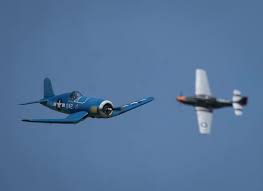Remote-Controlled Aircraft Ignites Grass Fire in Metro Area Incident
The Spark that Started More Than Just Conversation
When thinking of remote-controlled aircraft, many picture a serene setting with hobbyists meticulously directing their aerial wonders through clear skies. However, a recent incident in a bustling metro area flipped this idyllic image on its head, as a remote-controlled aircraft became the unlikely catalyst of a grass fire.
How It All Unfolded
The tranquil afternoon was abruptly interrupted when an enthusiast’s beloved RC plane took an unexpected nosedive into a patch of dry grass. Despite its diminutive size, the crash had big consequences. Witnesses reported that sparks flew from the miniature aircraft, igniting the surrounding vegetation.
Local authorities were quick to respond to the emerging fire. Efforts to contain the blaze were executed with speed and precision, preventing any harm to nearby structures or individuals. Nonetheless, the event has sparked conversation about the potential risks associated with remote-controlled flying activities, especially in such dry conditions.
Lessons Learned and Safety Measures
The Importance of Safety Guidelines
This incident underscores the critical importance of adhering to safety guidelines when participating in RC activities. Here are essential precautions to keep in mind:
- Inspect Equipment: Regularly check your aircraft for any signs of wear and tear that might result in operational failure.
- Mind the Weather: Be aware of weather conditions, particularly dry spells that could increase fire hazards.
- Choose Safe Locations: Operate in open spaces away from flammable materials to minimize risk.
- Have an Emergency Plan: Equip yourself with firefighting equipment such as a small extinguisher or sand to stifle sparks promptly.
The Science Behind the Spark
The science of how a small RC aircraft could ignite a patch of grass is as fascinating as it is alarming. These aircraft are often powered by lithium-polymer (LiPo) batteries, known for their high energy density and volatility. A crash can easily rupture the battery, releasing stored energy in the form of heat and causing a short-circuit that ignites flammable surroundings.
The Role of Environmental Conditions
Earth, wind, and fire might sound like the name of a band, but in this case, they played more practical—and perilous—roles. Dry grasses and gusty winds can combine to spread flames rapidly, underscoring the importance of knowing your environment and planning accordingly.
Always Room for Improvement
This incident has shone a light on the necessity for manufacturers to continually enhance the safety features of RC planes. As innovations such as failsafe systems and fire-retardant materials advance, enthusiasts can hope for an even more secure flying experience in the future.
The Community’s Response
The RC community’s reaction to this incident has been overwhelmingly constructive. Many enthusiasts are taking this opportunity to discuss ways to mitigate risks and enhance safety protocols. Local clubs and online forums are bustling with conversation, offering a treasure trove of advice which new and veteran hobbyists alike can benefit from.
Continuing the Flight – Safely
While this grass fire incident has prompted concern, it serves as an essential reminder of the responsibilities that come with flying remote-controlled aircraft. Having fun doesn’t mean tossing caution to the wind; instead, it’s a balancing act that combines thrill with safety, imagination with responsibility.
Engage and Stay Informed
Part of the adventure of flying RC helicopters and planes is being part of a learning community. Whether you’re a seasoned flyer or someone just getting their wings wet, staying informed and connected is crucial. Engage with your local RC clubs, attend workshops, and never hesitate to reach out for advice.
For those looking to delve deeper into the world of Remote control aircraft or explore the latest technological advancements in RC vehicles, exciting discoveries await around the next corner—or perhaps, above the next hill.
In the end, the sky is indeed the limit. As long as we aim high and land safely, the future of remote-controlled aviation promises innovation, excitement, and above all, a secure flight path for enthusiasts worldwide.






